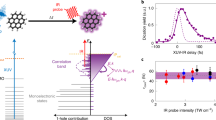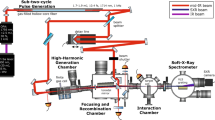Abstract
Ultrafast dynamics in atomic, molecular and condensed-matter systems are increasingly being studied using optical-pump, X-ray probe techniques where subpicosecond laser pulses excite the system and X-rays detect changes in absorption spectra and local atomic structure1,2,3. New opportunities are appearing as a result of improved synchrotron capabilities and the advent of X-ray free-electron lasers4,5. These source improvements also allow for the reverse measurement: X-ray pump followed by optical probe. We describe here how an X-ray pump beam transforms a thin GaAs specimen from a strong absorber into a nearly transparent window in less than 100 ps, for laser photon energies just above the bandgap. We find the opposite effect—X-ray induced optical opacity—for photon energies just below the bandgap. This raises interesting questions about the ultrafast many-body response of semiconductors to X-ray absorption, and provides a new approach for an X-ray/optical cross-correlator for synchrotron and X-ray free-electron laser applications.
This is a preview of subscription content, access via your institution
Access options
Subscribe to this journal
Receive 12 print issues and online access
$209.00 per year
only $17.42 per issue
Buy this article
- Purchase on Springer Link
- Instant access to full article PDF
Prices may be subject to local taxes which are calculated during checkout




Similar content being viewed by others
References
Bostedt, C. et al. Experiments at FLASH. Nuclear Instruments & Methods in Physics Research Section A—Accelerators Spectrometers Detectors and Associated Equipment 601, 108–122 (2009).
Glownia, J. M. et al. Time-resolved pump–probe experiments at the LCLS. Opt. Express 18, 17620–17630 (2010).
Bressler, C. & Chergui, M. Molecular structural dynamics probed by ultrafast X-ray absorption spectroscopy. Annu. Rev. Phys. Chem. 61, 263–282 (2010).
McNeil, B. W. J. & Thompson, N. R. X-ray free-electron lasers. Nature Photon. 4, 814–821 (2010).
Emma, P. et al. First lasing and operation of an angstrom-wavelength free-electron laser. Nature Photon. 4, 641–647 (2010).
Kraessig, B. et al. A simple cross-correlation technique between infrared and hard X-ray pulses. Appl. Phys. Lett. 94, 171113 (2009).
Gahl, C. et al. A femtosecond X-ray/optical cross-correlator. Nature Photon. 2, 165–169 (2008).
Ziaja, B., London, R. A. & Hajdu, J. Ionization by impact electrons in solids: electron mean free path fitted over a wide energy range. J. Appl. Phys. 99, 033514 (2006).
Schafer, W. & Wegener, M. Semiconductor Optics and Transport Phenomena, Advanced Texts in Physics (Springer, 2002).
Mcguire, E. J. Atomic L-shell Coster–Kronig, Auger, and radiative rates and fluorescence yields for Na-Th. Phys. Rev. A 3, 587–594 (1971).
Moss, T. S. The interpretation of the properties of indium antimonide. Proc. Phys. Soc. London B 67, 775–782 (1954).
Burstein, E. Anomalous optical absorption limit in InSb. Phys. Rev. 93, 632–633 (1954).
Van Mieghem, P. Theory of band tails in heavily doped semiconductors. Rev. Mod. Phys. 64, 755–793 (1992).
Sze, S. M. & Ng, K. K. Physics of Semiconductor Devices 3rd edn (Wiley-Interscience, 2007).
Liebler, J. & Haug, H. Theory of the band-tail absorption saturation in polar semiconductors. Phys. Rev. B 41, 5843–5856 (1990).
Oudar, J. L., Hulin, D., Migus, A., Antonetti, A. & Alexandre, F. Subpicosecond spectral hole burning due to non-thermalized photoexcited carriers in gaas. Phys. Rev. Lett. 55, 2074–2077 (1985).
Schoenlein, R. W., Lin, W. Z., Ippen, E. P. & Fujimoto, J. G. Femtosecond hot-carrier energy relaxation in GaAs. Appl. Phys. Lett. 51, 1442–1444 (1987).
Nunnenkamp, J., Collet, J. H., Klebniczki, J., Kuhl, J. & Ploog, K. Subpicosecond kinetics of band-edge absorption in Al0.25Ga0.75As. Phys. Rev. B 43, 14047–14054 (1991).
Chang, Y. M. & Chang, N. A. Coherent longitudinal optical phonon and plasmon coupling in GaAs. Appl. Phys. Lett. 81, 3771–3773 (2002).
Rupper, G., Kwong, N. H. & Binder, R. Large excitonic enhancement of optical refrigeration in semiconductors. Phys. Rev. Lett. 97, 117401 (2006).
Khurgin, J. B. Role of bandtail states in laser cooling of semiconductors. Phys. Rev. B 77, 235206 (2008).
Sturge, M. D. Optical absorption of gallium arsenide between 0.6 and 2.75 eV. Phys. Rev. 127, 768–773 (1962).
Banyai, L. & Koch, S. W. A simple theory for the effects of plasma screening on the optical-spectra of highly excited semiconductors. Zeitschrift Fur Physik B 63, 283–291 (1986).
Grilli, E., Guzzi, M., Zamboni, R. & Pavesi, L. High-precision determination of the temperature-dependence of the fundamental energy-gap in gallium-arsenide. Phys. Rev. B 45, 1638–1644 (1992).
Passler, R. Dispersion-related description of temperature dependencies of band gaps in semiconductors. Phys. Rev. B 66, 085201 (2002).
Trigo, M. et al. Imaging nonequilibrium atomic vibrations with X-ray diffuse scattering. Phys. Rev. B 82, 235205 (2010).
Graber, T. et al. BioCARS: a synchrotron resource for time-resolved X-ray science. J. Synch. Rad. 18, 658–670 (2011).
Henke, B. L., Gullikson, E. M. & Davis, J. C. X-ray interactions—photoabsorption, scattering, transmission, and reflection at e = 50–30,000 eV, z = 1–92. Atomic Data and Nuclear Data Tables 54, 181–342 (1993).
Acknowledgements
This research was supported by the US Department of Energy, Office of Basic Energy Science (award no. DE-SC0004078). Use of the Advanced Photon Source was supported by the US Department of Energy, Basic Energy Sciences, Office of Science (contract no. DE-AC02-06CH11357). Use of the BioCARS Sector 14 was supported by the National Institutes of Health, National Center for Research Resources (grant no. RR007707). The time-resolved set-up at Sector 14 was funded in part through a collaboration with Philip Anfinrud (NIH/NIDDK).
Author information
Authors and Affiliations
Contributions
All four authors were substantially involved with acquiring the data. S.M.D. analysed the results and wrote the manuscript, with assistance from T.G.
Corresponding author
Ethics declarations
Competing interests
The authors declare no competing financial interests.
Rights and permissions
About this article
Cite this article
Durbin, S., Clevenger, T., Graber, T. et al. X-ray pump optical probe cross-correlation study of GaAs. Nature Photon 6, 111–114 (2012). https://doi.org/10.1038/nphoton.2011.327
Received:
Accepted:
Published:
Issue Date:
DOI: https://doi.org/10.1038/nphoton.2011.327
This article is cited by
-
Core-level nonlinear spectroscopy triggered by stochastic X-ray pulses
Nature Communications (2019)
-
Quantitative X-ray phase-contrast microtomography from a compact laser-driven betatron source
Nature Communications (2015)
-
Time-resolved observation of band-gap shrinking and electron-lattice thermalization within X-ray excited gallium arsenide
Scientific Reports (2015)
-
Performance improvement of a Kα source by a high-resolution thin-layer-graphite spectrometer and a polycapillary lens
Applied Physics B (2014)
-
Dispersive Fourier transformation for fast continuous single-shot measurements
Nature Photonics (2013)



